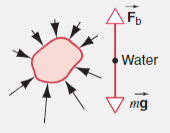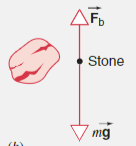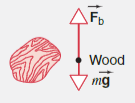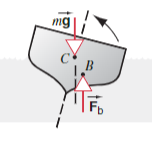Buoyancy, or the buoyant force, uses Archimedes’ Principle:
Archimedes' Principle
Archimedes’ Principle states that:
Link to originalA body wholly or partially immersed in a fluid is buoyed up by a force equal in magnitude to the weight of the fluid displaced by the body.
Because of the Variation of Pressure for Fluids at Rest, the Pressure on the bottom of a submerged object is higher than the pressure at the top of a submerged object, resulting in a buoyant force. When the density of the object is the same as that of the fluid, the object’s weight balances with the buoyant force.
 When the density of the object is greater than that of the fluid, the volume of water that it displaces is less than its own weight. As a result, it sinks. Its weight
When the density of the object is greater than that of the fluid, the volume of water that it displaces is less than its own weight. As a result, it sinks. Its weight  Alternatively, when the density of the object is less than that of the fluid, the volume of water than it displaces is greater than its own weight. As a result, it floats. Its weight
Alternatively, when the density of the object is less than that of the fluid, the volume of water than it displaces is greater than its own weight. As a result, it floats. Its weight  The buoyant force acts at the Center of Gravity of the submerged portion of the object. This point is known as the Center of Buoyancy. When the Center of Gravity and the Center of Buoyancy are not vertical, the submerged object will tilt.
The buoyant force acts at the Center of Gravity of the submerged portion of the object. This point is known as the Center of Buoyancy. When the Center of Gravity and the Center of Buoyancy are not vertical, the submerged object will tilt.
